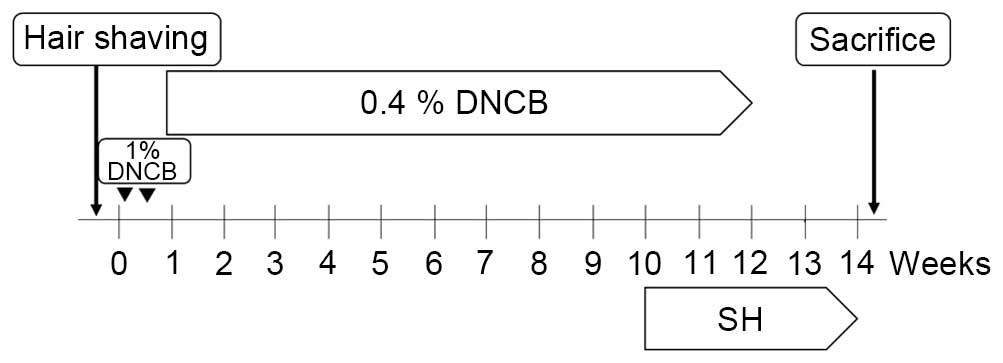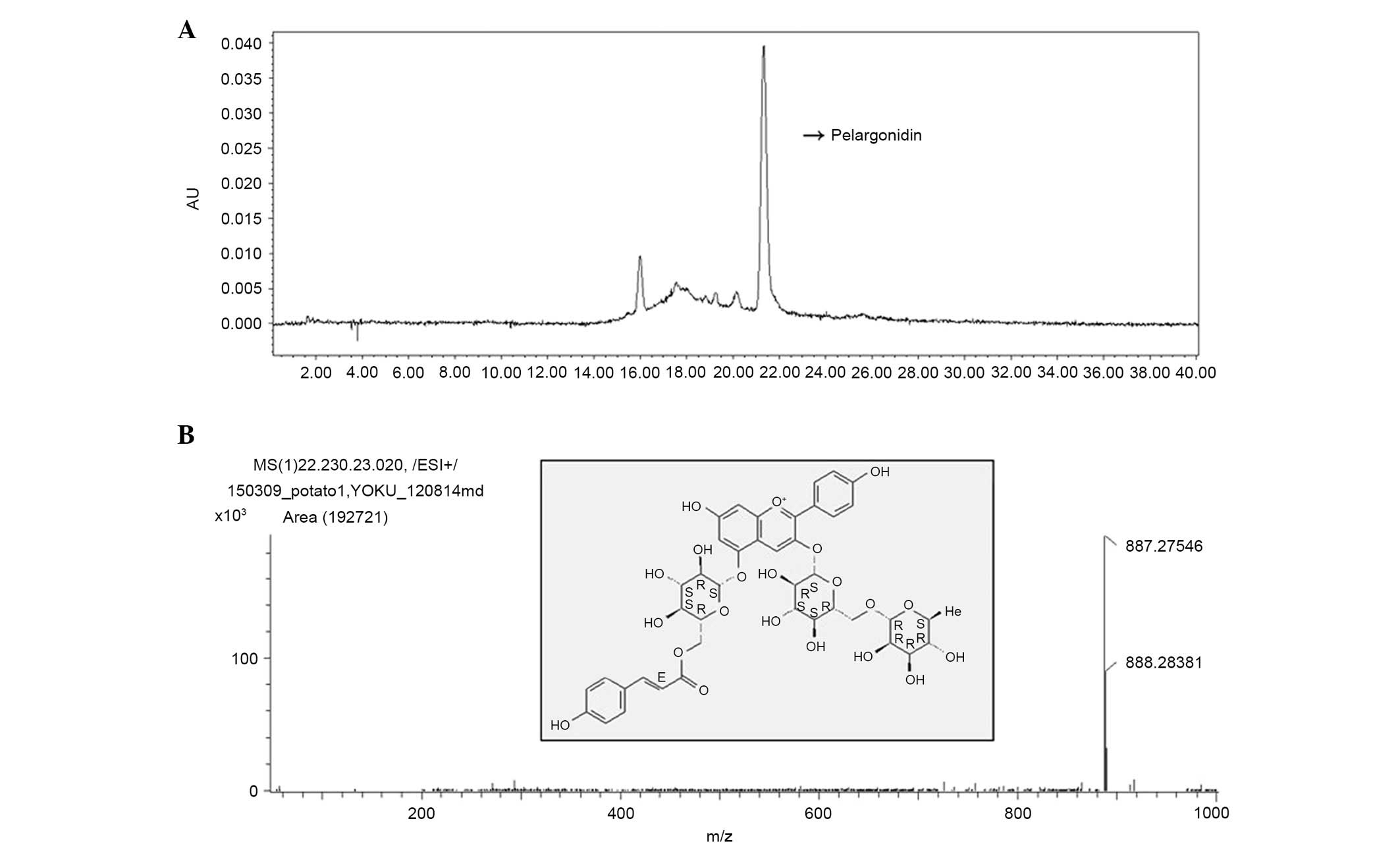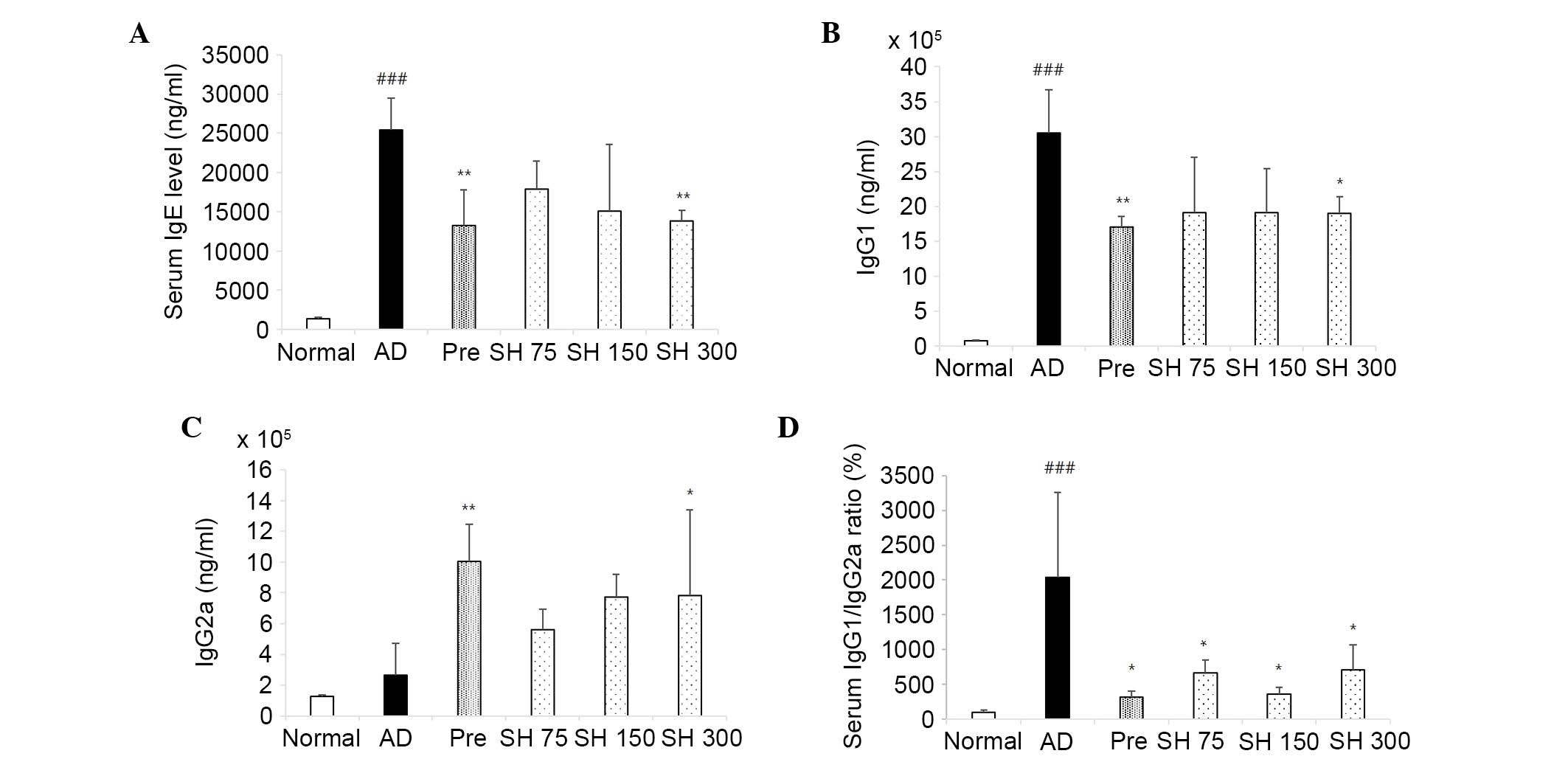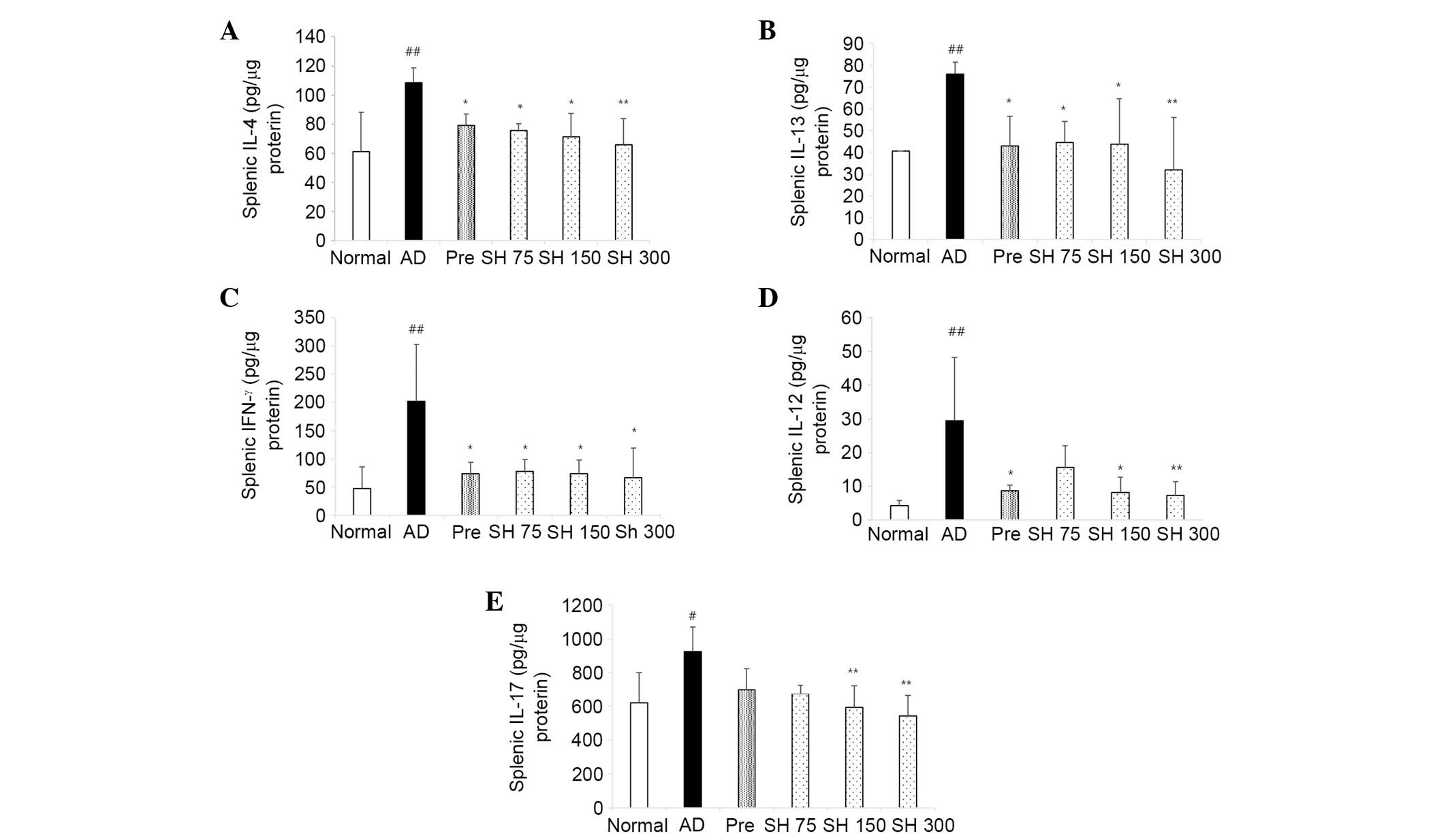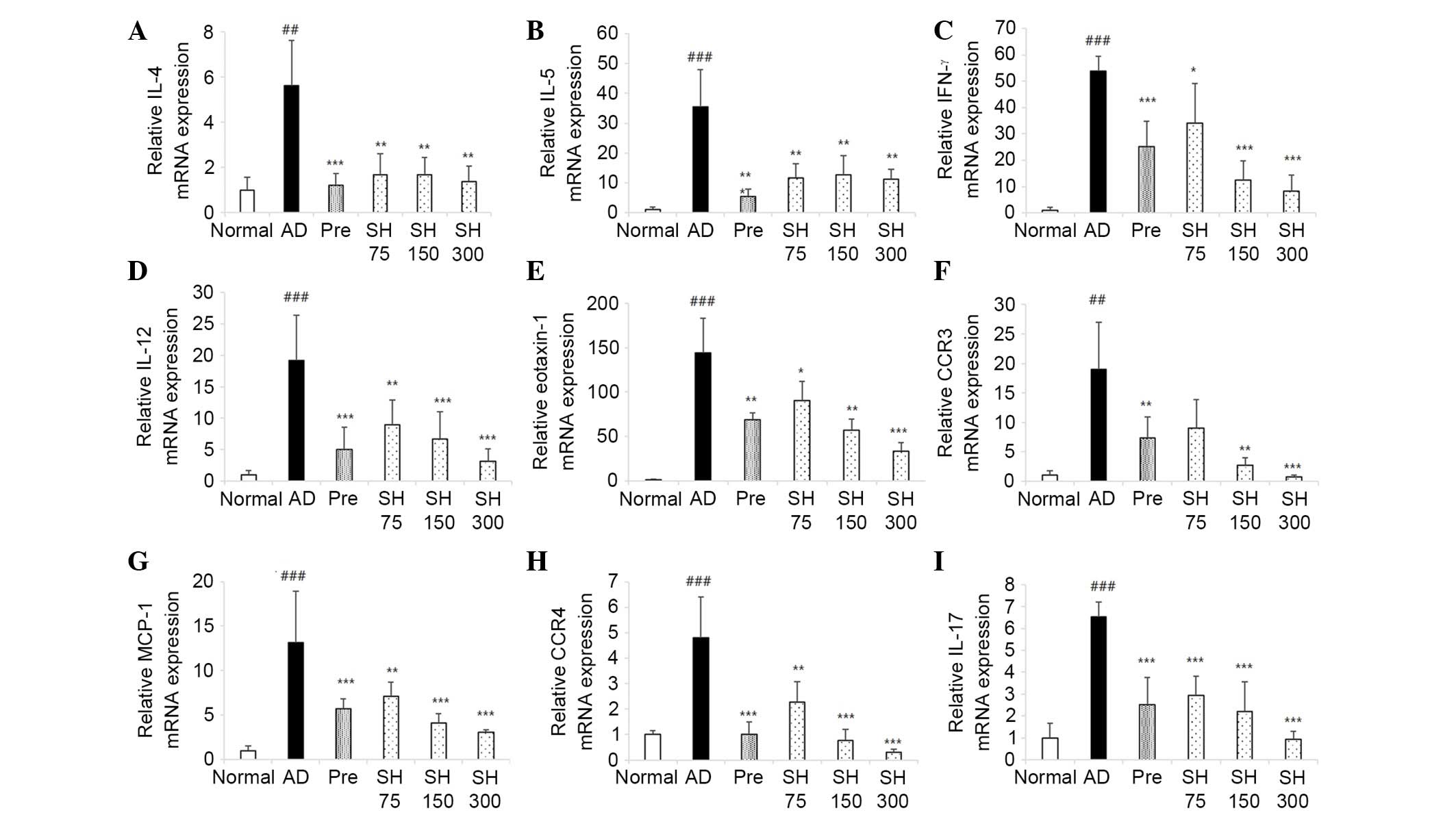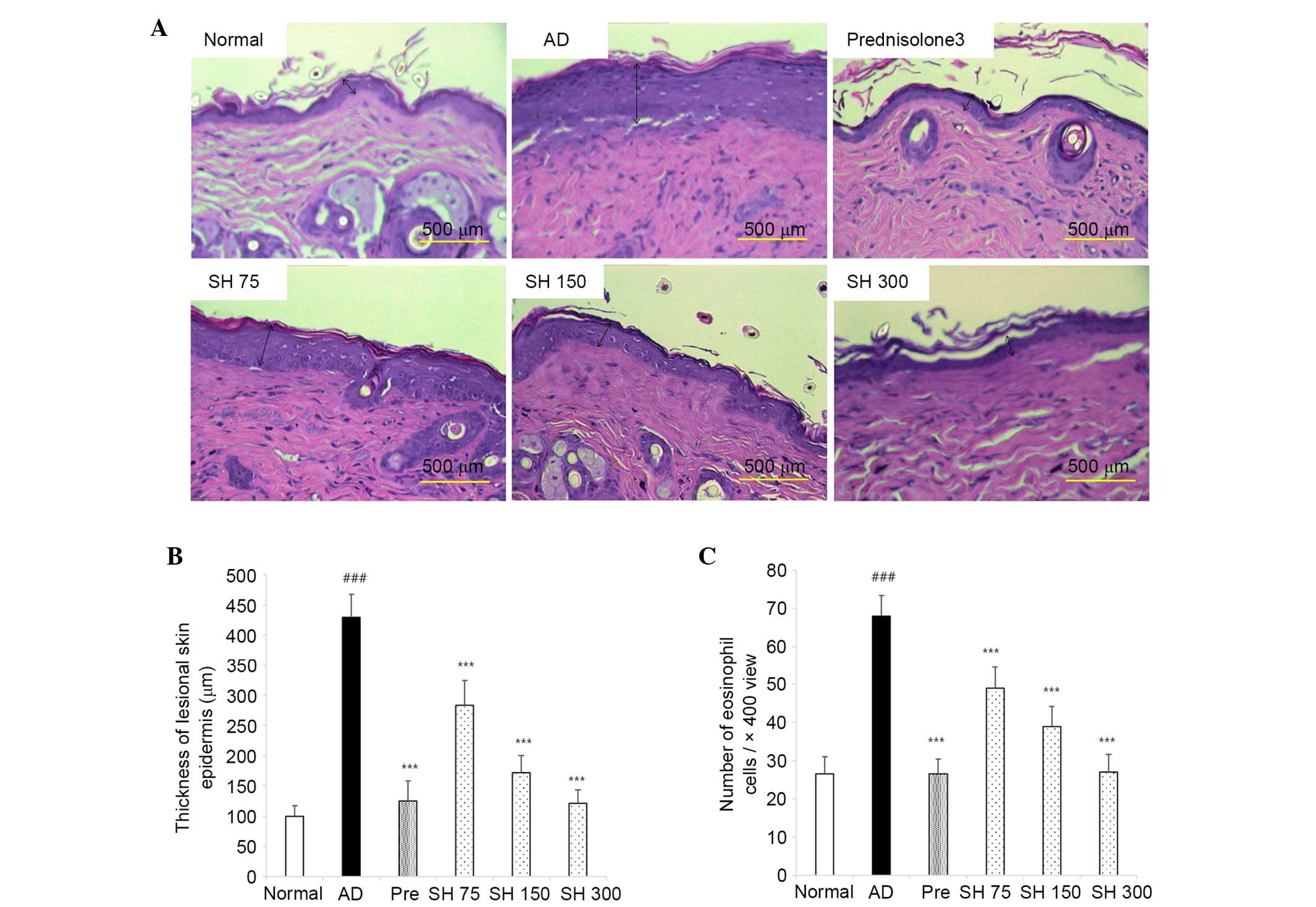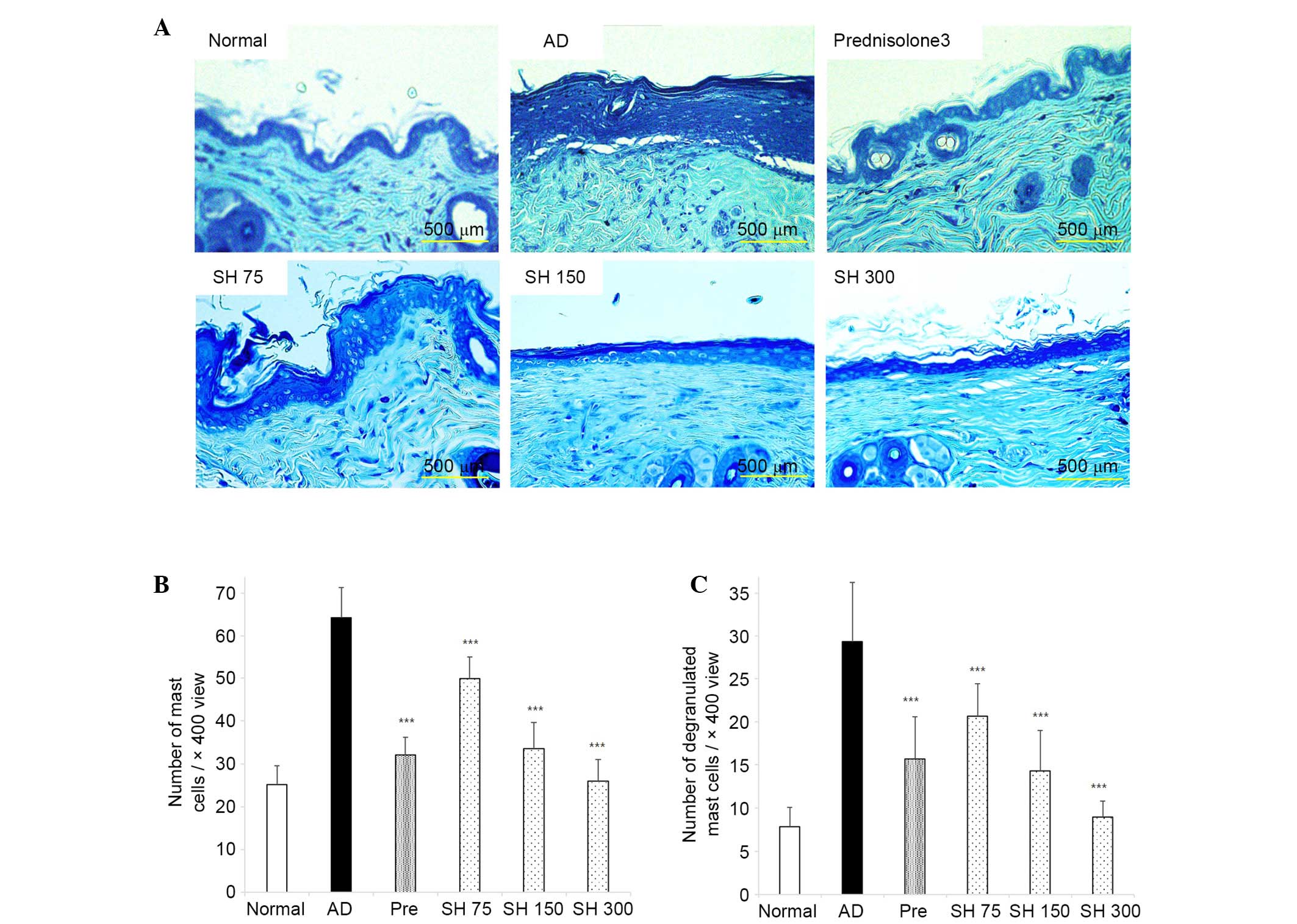Solanum tuberosum L. cv Hongyoung extract inhibits 2,4‑dinitrochlorobenzene‑induced atopic dermatitis in NC/Nga mice
- Authors:
- Published online on: August 8, 2016 https://doi.org/10.3892/mmr.2016.5595
- Pages: 3093-3103
-
Copyright: © Kang et al. This is an open access article distributed under the terms of Creative Commons Attribution License.
Abstract
Introduction
Atopic dermatitis (AD) is a relapsing skin inflammatory disease with acute and chronic phases, which is characterized by acute pruritus and eczema (1). Skin inflammation is caused by complex interactions between genetic, environmental, pharmacological, psychological, immunological and skin barrier dysfunction factors (2). The prevalence of AD is rapidly increasing in industrialized countries, particularly among children (3). The immunological mechanism underlying AD remains to be fully elucidated; however, a study regarding AD immunopathology have demonstrated that AD is highly correlated with immune system dysregulation (4).
In human AD, skin inflammation occurs when the skin is damaged by pruritus-induced scratching, and is followed by rapidly developing erythema, hemorrhage, scarring, dryness, and skin lesion hyperplasia (5). This type of dermatitis is associated with increased production of proinflammatory cytokines, which activate various types of immune cell, consequently initiating the AD inflammatory cycle. Interleukin (IL)-4, IL-5 and IL-13, which are produced by T-helper (Th)2 cells, may have important roles in the acute phase of AD (6). Th2 cells mediate immunoglobulin (Ig)E production via the release of cytokines and chemical mediators (7). Increased IgE levels are a hallmark of AD, and increased IL-4 levels are associated with IgE elevation in B cells. IgE is released from B cells and binds to mast cells, which release various biological mediators, particularly histamine, in IgE-mediated AD (2).
Although Th2 cytokines are dominant in the acute phase of AD, Th1 cytokines, including interferon (IFN)-γ and IL-12, are expressed and are associated with the pathogenesis of AD in the chronic phase (8). Recently, T regulatory (Treg) cells, which are a subtype of T cell, have been reported to have an important role in the modulation of allergic and autoimmune responses, and are characterized by the dominant transcription of forkhead box P3, a forkhead/winged helix transcription factor gene, which is the fingerprint of native Treg cells (9). Th1/Th2 polarization is well-defined in murine models induced by artificial immunization. Specifically, AD is an allergic disease that results from dermal inflammation, a hallmark characteristic of which is a disruption in the immunological balance between Th1 and Th2 cells (10). It has previously been suggested that IL-17-producing CD4+ T-helper cells (Th17) participate in the pathogenesis of AD (11). In Th1-mediated chronic inflammatory disease with epidermal hyperplasia, IL-17 has been reported to be associated with allergen-specific immune responses (12).
At present, steroid therapy is widely applied for the treatment of AD; however, since this treatment causes severe side effects, including immunosuppression, stretch marks, thinning of the skin, and epidermal barrier dysfunction, it cannot be used for long periods of time (13). Therefore, a study investigated the potential of natural substances for the treatment of patients with AD (14).
Solanum tuberosum L. cv Hongyoung (SH) is a variety of potato with red skin and flesh. This variety possesses numerous anthocyanins, which the general potato does not (15); their high anthocyanin content is due to the pigments that are responsible for their color (16). Anthocyanin concentration varies in the large range of potatoes, and is correlated with the degree of pigmentation in colored potato flesh. It has previously been reported that a high intake of anthocyanin-rich food is associated with health protective effects, and a reduced risk of diabetes, arthritis and cancer, partially due to their antioxidant and anti-inflammatory activities (17). The present study aimed to determine the effects of a water extract of SH on the skin symptoms of NC/Nga mice treated with a repeated topical application of 2,4-dinitrochlorobenzene (DNCB). The inhibitory effects of SH extract were detected on the development of AD in vivo.
Materials and methods
Reagents
RPMI 1640 medium, penicillin, streptomycin, phosphate-buffered saline (PBS) and fetal bovine serum (FBS) were purchased from Hyclone (GE Healthcare Life Sciences, Logan, UT, USA).
DNCB, concanavalin A (Con A) and prednisolone were obtained from Sigma-Aldrich (St. Louis, MO, USA). Mouse enzyme-linked immunosorbent assay (ELISA) kit for IgE was obtained from Shibayagi (Shibukawa, Japan). Mouse ELISA kits for IL-4, IgG1 and IgG2 were purchased from Enzo Life Sciences (UK) Ltd. (Exeter, UK). IL-13, IFN-γ, and IL-17 ELISA kits were purchased from eBioscience, Inc. (San Diego, CA, USA). The ELISA kit for IL-12 was purchased from Bioo Scientific (Austin, TX, USA). TRIzol® reagent was purchased from Invitrogen (Thermo Fisher Scientific, Inc., Waltham, MA, USA). Oligo dT and MMLV transcriptase were obtained from Promega Corporation (Madison, WI, USA), and SYBR Green supermix was purchased from Takara Bio Inc. (Otsu, Japan).
Preparation of SH extracts
SH was supplied by Hamyang-gun Agricultural Development & Technology Center (Hamyang, South Korea). SH was cut into slices (1 cm), and treated with 80% aqueous ethanol for 24 h at room temperature. This procedure was repeated twice. After filtration, the solvent was vaporized under low pressure, and the filtrate was diluted with distilled water. After freeze-drying, the resulting extract powder was maintained at −70°C until further use.
High-performance liquid chromatography (HPLC) analysis
The HPLC instrument used consisted of Waters HPLC (separation module 2690), photodiode array detector 2996 running Empower software, and Atlantis T3 C18 column (4.6×150 mm, 5 μm) (Waters Corporation, Milford, MA, USA). The mobile phase consisted of acidified acetonitrile with formic acid (0.1%, solvent A) and acidified water with formic acid (0.1%, solvent B), which were eluted at a flow rate of 1.0 ml/min. The gradient program for SH was 0–10 min, 10% solvent A; 60 min, 40% solvent A; 80 min, 80% solvent A; 81 min, 100% solvent A. Briefly, 30 mg SH extract powder was dissolved in 1 ml 100% methanol, and was adjusted to pH 2.0 using formic acid. A 10 μl aliquot of the sample solution was injected into the HPLC system following filtration with a 0.45 μm syringe filter (EMD Millipore, Bedford, MA, USA). HPLC analysis was performed at 520 nm at room temperature. Identification of major peaks was performed according to a HPLC-electrospray ionization (ESI)-mass spectrometry (MS) study. AccuTOF® single-reflectron time-of-flight mass spectrometer was equipped with an ESI source (JEOL USA, Inc., Peabody, MA, USA) and was operated with MassCenter system version 1.3.7b (JEOL USA, Inc.). MS spectra obtained in the positive ion mode were more informative than those obtained from the negative ion mode; therefore, acquisition was performed in the positive ion mode. The parameters were as follows: Orifice 1=30 V; ring lens and orifice 2=15 and 10 V, respectively. The ion guide potential and detector voltage were set to 2,200 V. ESI parameter needle electrode=1,500 V; nitrogen gas was used as a nebulizer, flow rate 1–3 l/min, desolvating chamber temperature=250°C, orifice 1 temperature=80°C. Mass scale calibration was accomplished using the YOKUDELNA calibration kit (JEOL Ltd., Tokyo, Japan) for accurate mass measurements.
Animals
Male NC/Nga mice (age, 4 weeks; weight, 16 g) were obtained from SLC (SLC, Inc., Shizuoka, Japan) and were stored in standard cages (individually ventilated cages) at 23±3°C in an atmosphere containing 55±5% humidity. The mice were maintained under a 12/12 h light/dark cycle in specific pathogen-free conditions at the Animal Research Center at Kyung Hee University (Seoul, North Korea). The mice were allowed ad libitum access to Purina rodent chow (Raonbion, Seoul, Korea) and tap water. All mice were acclimated for 7 days prior to commencement of the experiments. Experimental protocols were performed in accordance with the Standard Operating Procedure recognized by the National Institutes of Health Guide for the Care and Animal Welfare Act and Use of Laboratory Animals (Approval number KHP-2014-04-1-R1). The study was approved by the ethics committee of the Department of Life and Nanopharmaceutical Science of Pharmacy, College of Pharmacy, Kyung Hee University (Seoul, Korea).
Treatment
To induce AD-like skin lesions, hair on the ears and dorsal skin of NC/Nga mice was removed using hair removal cream and an electric shaver twice a week. On the subsequent day, 200 μl 1% DNCB solution (dissolved in 2:3 mixture of acetone and olive oil) was applied to the shaved dorsal area (~8 cm2) (Fig. 1). On day 4 after the initial sensitization, 200 μl 1% DNCB mixture was applied to the shaved dorsal area for the second sensitization. On day 7 after the initial sensitization, the dorsal skin and ears of the mice were challenged with 150 μl 0.4% DNCB mixture (0.4% DNCB dissolved in a 3:1 mixture of acetone and olive oil). After the first challenge, 0.4% DNCB solution was repeatedly applied to the dorsal skin and ears 3 times a week for 9 weeks. The mice were allocated to six groups (n=8/group): Normal control group, negative control group, positive control group, and SH extract-treated groups, which received 75, 150 or 300 mg/kg·body weight (bw) SH extract. SH extract was orally administered daily for 4 weeks, starting 9 weeks after sensitization with 1% DNCB. The normal and negative control groups were treated with 0.5% carboxymethyl cellulose (CMC), and the positive control group was administered prednisolone (3 mg/kg·bw) dissolved into 0.5% CMC (Table I).
Scoring of skin dermatitis severity and ear thickness
Following sample treatment, right ear thickness was gauged three times per week using a thickness gauge (Mitutoyo Corporation, Tokyo, Japan). Total clinical severity score was evaluated three times a week. The extent of dryness, lichenification, excoriation, erythema/edema and erosion was scored as follows: 0, no symptoms; 1, mild symptoms; 2, moderate symptoms; and 3, severe symptoms. The total skin score was defined as the sum of the individual scores (18).
Established scratching behavior
Scratching behavior was observed following completion of the treatments. Specifically, scratching was counted three times a week. Mice from each group were placed into a new cage for 1 h of habituation. The number of times a mouse scratched the dorsal skin lesion within a period of 30 min was counted (19). Scratching behavior was scored from 0 to 4, as follows: 0, no scratching; 2, scratching shorter than 1.5 sec; and 4, scratching longer than 1.5 sec. The total scratching behavior number was calculated as the sum of the individual scores (20).
Plasma Ig analysis
The immunological response during DNCB-induced AD was monitored by measuring the serum levels of IgE, IgG1 and IgG2a. The plasma levels of IgE were measured using the mouse IgE ELISA kit, and IgG1 and IgG2a levels were measured using mouse IgG1 and IgG2a ELISA kits. The ELISAs were performed according to manufacturers' protocols.
Cytokine production by splenocytes
Each group of mice was sacrificed by overdose of diethyl ether, and the spleens from each mouse were obtained. Spleens isolated from NC/Nga mice were crushed using a cell strainer (BD Biosciences, Franklin Lakes, NJ, USA) and were then resuspended in culture medium (RPMI-1640 supplemented with 10% FBS, 50 mg/ml streptomycin and 100 U/ml penicillin). Splenocytes were cultured in 24-well plates at a cell density of 1×106 cells/ml. Briefly, splenocytes were treated with 5 μg/ml Con A and were incubated in a 5% CO2 incubator for 72 h at 37°C. Subsequently, the supernatants were harvested to determine the levels of IL-4, IL-13, IFN-γ, IL-12 and IL-17A using ELISA kits in accordance with the manufacturers' protocols.
Reverse transcription-quantitative polymerase chain reaction (PCR) analysis
Tissues were homogenized and total RNA was isolated from the right ear lesional tissue using TRIzol® reagent. Isolated RNA underwent reverse transcription and was amplified by PCR using MMLV reverse transcriptase (Promega Corporation), 5X buffer, 10 mM deoxyribonucleotide triphosphates mix, RNase inhibitor and Oligo dT at 42°C for 1 h, 94°C for 5 min and 4°C for 1 h. Subsequently, equal amounts of cDNA were mixed with 5 pM primer and SYBR Green supermix and were analyzed using an ABI StepOnePlus Real-Time PCR machine (Applied Biosystems; Thermo Fisher Scientific, Inc.). The primer sets used in the PCR amplification are presented in Table II. The reactions were set up in a total volume of 20 μl using 0.5 μl of cDNA and 10 μl of 2X Taqman probe mix (Applied Biosystems). Amplification was performed under the following cycling conditions: 95°C for 10 min, followed by 40 cycles of 95°C for 15 sec, 60°C for 1 min, and 72°C for 20 sec. The mRNA expression levels of each gene were normalized to the levels of β-actin. According to the comparative Cq method, gene expression was normalized to the expression of the housekeeping β-actin. The gene expression level, normalized to the housekeeping gene and relative to the control sample, was calculated as the 2−ΔΔCq (21).
Histological analysis
After the mice were sacrificed, the dorsal skin and one ear from each mouse was fixed in 10% buffered neutral formalin. Paraffin-embedded dorsal skin samples from the mice were sectioned into 4 μm slices, which were then stained with hematoxylin and eosin (H&E) or toluidine blue for 4 h at 2–4°C in order to measure the number of various inflammatory cells and mast cells, respectively. The sections were examined by light microscopy to assess histological alterations.
Statistical analysis
Data are presented as the mean ± standard error of the mean. Differences between groups were detected using SPSS 21 (IBM, Armonk, NY, USA) by one-way analysis of variance followed by Tukey's test. P<0.05 was considered to indicate a statistically significant difference.
Results
HPLC profile of SH
To identify the effective compound from SH, HPLC analysis was performed at 520 nm. As shown in Fig. 2, the major peak in the total ion chromatogram at 21 min corresponds with the main peak from the HPLC chromatogram. The major anthocyanin was identified by HPLC-ESI-MS and MS/MS using full spectral scan, precursor ion scan, and product ion scan experiments, demonstrated the molecular and aglycone ions at m/z 877, 725, 433 and 271, which indicated the presence of pelargonidin-3-couma-roylrutinoside-5-O-glucoside. The major anthocyanin peak was identified by HPLC-ESI-MS using a full spectral scan, precursor ion scan and product ion scan experiments. The difference in molecular masses of 20 mmu indicated the presence of pelargonidin-3-coumaroylrutinoside-5-O-glucoside. The chemical structure of the anthocyanin is shown in Fig. 2.
Effects of SH extract on DNCB-induced AD-like skin lesions and ear thickness in Nc/Nga mice
To evaluate the effectiveness of SH extract against AD-like skin lesions, post-induction of AD-like skin lesions by DNCB application, the mice were treated with 75, 150 or 300 mg/kg SH extract daily for 4 weeks. Skin conditions were investigated three times a week for 4 weeks according to dermatitis severity scores. Repeated DNCB application significantly increased dermatitis severity scores, and induced hemorrhage, edema, scarring, dryness and erosion in NC/Nga mice (Fig. 3). As shown in Fig. 4A, DNCB-induced AD symptoms were suppressed by SH extract or prednisolone compared with in the AD group. Repeated application of DNCB also significantly increased ear thickness in mice, as compared with in the normal group. In addition, ear lesions exhibited hyper-keratosis and dermal thickening in the DNCB-treated group compared with in the control group. These symptoms were all suppressed by SH extract and prednisolone treatments (Fig. 4B). These results indicate that SH extract decreases AD symptoms in NC/Nga mice.
Effects of SH extract on scratching behavior
To investigate the effects of SH extract on scratching behavior, the number of times a mouse scratched the dorsal skin lesion within a period of 30 min was counted 1 h after sample treatment. As shown in Fig. 4C, the SH-treated and positive control groups exhibited reduced scratching behavior compared with the negative control group. Between weeks 2 and 3, the SH 150 and 300 mg/kg groups exhibited significantly reduced scratching behavior compared with the AD control group. These results indicate that SH extract and prednisolone decrease AD symptom-like scratching.
Effects of SH extract on serum Ig levels
In addition to clinical features, the levels of IgE, IgG1 and IgG2a were detected in serum samples from NC/Nga mice in order to characterize the immunological response during disease progression.
Excessive production of IgE is associated with disease severity in patients with AD (22). Plasma IgE levels were detected in the mice treated with SH extract and compared with those of the control group. Mice were treated with 75, 150 or 300 mg/kg SH extract and prednisolone daily post-induction of AD-like skin lesions by DNCB application. As shown in Fig. 5A, repeated topical application of DNCB significantly increased the secretion of IgE compared with in the control group. Conversely, oral administration of SH extract (75, 150 or 300 mg/kg) or prednisolone decreased serum IgE levels by 29, 40, 45 and 47% for 4 weeks, respectively. AD is associated with dysregulation of the Th1/Th2 balance (23). SH extract was able to decrease the serum levels of Th2-mediated IgG1 and increase the levels of Th1-mediated IgG2a. As shown in Fig. 5B and C, DNCB induced increased IgG1 levels, which were decreased following treatment with SH extract (75, 150 and 300 mg/kg) and prednisolone. In addition, SH extract increased the production of IgG2a. As shown in Fig. 5D, the IgG1/IgG2a ratio was decreased in the SH extract and positive control groups. These results indicate that SH extract may alleviate AD-like skin symptoms through the upregulation of IgG2a (Fig. 5) and the concomitant downregulation of IgE and IgG1.
SH extract suppresses cytokine production in splenocytes
The present study investigated the inhibitory effects of SH extract on DNCB-induced cytokines produced by splenocytes. Spleens were collected from the NC/Nga mice treated with SH extract or prednisolone following sacrifice, and isolated splenocytes were stimulated with 5 μg/ml Con A and incubated for 72 h. Following incubation, the supernatants were collected, and the levels of IL-4 and IL-13 (Th2 cytokines), and IFN-γ and IL-12 (Th1 cytokines) were measured in the supernatant using ELISA kits. The Th2 cytokines, IL-4 and IL-13, are expressed in the acute stage of AD. The Th1 cytokines, IFN-γ and IL-12, are expressed in the chronic stage of AD. As shown in Fig. 6, repeated application of DNCB markedly increased the levels of Th1 and Th2 cytokines in the mice. The cytokine IL-4 was decreased by 26, 30, 34 and 39% in the prednisolone and SH extract groups (75, 150 and 300 mg/kg), respectively. IL-13 was decreased by 42, 41, 43 and 57%, respectively. IFN-γ was decreased by 64, 62, 64 and 67%, respectively. IL-12 levels were decreased by 70, 47, 72 and 75%, respectively. These results indicate that SH extract inhibits Th1 and Th2 cytokine levels compared with in the negative control group. In AD, increased numbers of Th17 cells and enhanced expression of IL-17 contribute to neutrophil chemotaxis and increased expression of antimicrobial peptides (24). As shown in Fig. 6, IL-17 was increased in the AD group, and was decreased by 24, 27, 35 and 42% in the prednisolone and SH extract groups (75, 150 and 300 mg/kg), respectively.
Effects of SH on DNCB-induced mRNA expression of IL-4, IL-13, IL-5, IL-12, IFN-γ, eotaxin, C-C chemokine receptor (CCR)3, CCR4, IL-17 and monocyte chemoattractant protein (MCP)-1 in NC/Nga mice
The present study investigated the inhibitory effects of SH extract on the mRNA expression levels of Th1, Th2 and Th17 cytokines, and chemokines in lesional skin. Repeated application of DNCB significantly increased the mRNA expression levels of IL-4, IL-5, IFN-γ, IL-12, eotaxin-1, CCR3, MCP-1, CCR4 and IL-17 in lesional skin; however, SH inhibited DNCB-induced cytokine and chemokine mRNA expression (Fig. 7). These results indicate that SH treatment may suppress DNCB-induced cytokine and chemokine expression, leading to inhibition of skin inflammation caused by the infiltration of inflammatory cells.
Effects of SH on DNCB-induced AD-like histopathological alterations in Nc/Nga mice
After the mice were sacrificed, dorsal and ear skin samples were sectioned, and stained with H&E and toluidine blue. As shown in Figs. 8 and 9, ear lesions exhibited hyperkeratosis, thickening of the epidermis, and inflammatory cells accumulated within the skin lesions. These symptoms were all suppressed by SH treatment. These results indicate that SH extract may effectively decrease AD symptoms in NC/Nga mice.
Discussion
AD is a chronic relapsing inflammatory, pruritic epidemic disease that affects people worldwide (2). Recent studies have markedly improved our knowledge regarding the immunological mechanisms that underlie the pathogenesis of AD (25). However, complex mutual associations between the immune system and environmental, genetic and immunological factors remain to be examined (1).
In AD, the existence of high numbers of CD4+ and CD8+ T cells has been demonstrated by culturing T cells from skin biopsies and by immunohistochemistry (26,27). Numerous studies have indicated the role of activated CD4+ T cells in AD (28,29). The cutaneous lymphocyte-associated antigen+ T cell infiltrate according to cytokine and chemokine receptor expression has disclosed novel T helper cell classification (Th1, Th2, Th17 and Treg cell subsets) that play an important role in AD (30). Reduced numbers of regulatory Treg cells, influenced by environmental and genetic factors, predispose individuals to the development of AD in early life (31). AD is characterized by skin lesions that result from dermal inflammation, a characteristic feature of which is a disruption in the immunological balance between Th1 and Th2 cells (9). The Th1/Th2 balance can be identified through the IgG2/IgG1 ratio, which is a marker for Th1 and Th2 lymphocytes (32). The present study investigated whether SH extract was able to modulate the Th1/Th2 balance and inhibit the development of DNCB-induced dermatitis in NC/Nga mice, a condition histologically and clinically similar to human AD. Solanum tuberosum varieties with intense blue-red colored pulp are well-known and widely used in the preparation of traditional dishes of local populations. Potatoes with purple-red flesh are considered good sources of appreciable amounts of phenolic acids, particularly acylated anthocyanins (33). The pigments responsible for the particular color of the tubers reflect their anthocyanin content (16). The major pigment present in SH extract is perelagonidin-3-cou-maroyl-rutinoside-5-O-glucoside. This compound is also expressed in other red-flashed potatoes (34). Previous studies have reported that anthocyanins exert anti-inflammatory and anticancer activities (35,36). In the present study, the pathogenesis of DNCB-induced contact hypersensitivity resulted from T cell-mediated immune responses (37). In DNCB-induced AD, Th2 cytokines are expressed in the acute phase, whereas Th1 cytokines are expressed and contribute to the pathogenesis of AD in the chronic phase (38). In the acute phase, the Th2 cytokines IL-4 and IL-13 mediate the secretion of IgE in B cells (39). Mast cells are stimulated in response to active cross-linking of AD-specific IgE with high affinity cell-surface IgE-receptors, and degranulated mast cells release active mediators, including histamine (40). In the chronic phase, Th1 cytokines IL-12 and IFN-γ are produced, inducing a local Th1 response and tissue alterations, such as dermal thickening (41). Another feature of AD is the presence of characteristic inflammatory dendritic cell subtypes in the dermis and epidermis (42). Antigen-presenting cells, such as CD1a+ epidermal dendritic cells, dermal dendritic cells, and monocytes appear to have an important role in AD, and typically express the high-affinity receptor for IgE (FceRI) (43). Stimulation of FceRI on the surface of inflammatory dendritic epidermal cells induces the release of IL-12 and IL-18 (44). These cytokines may contribute to the switch from the initial Th2 immune response in acute AD to the Th1 polarization of T cells in the chronic phase (44). Keratinocytes of patients with AD release higher amounts of several proinflammatory cytokines and chemokines, as compared with keratinocytes from non-AD skin (45). Keratinocytes respond to Th1 and Th2 cytokines from T cells (46). The Th1 cytokine IFN-γ is one of the most potent keratinocyte-activating factors (47). In keratinocytes, inflammatory chemokines, including C-C motif chemokine ligand (CCL)3, CCL4, CCL11/eotaxin-1 and CCL2/MCP-1 have been reported to be associated with AD characteristics and may support leukocyte recruitment (48). The C-C chemokine family adaptive immune responses are induced via dendritic cells, basophils, mast cells, lymphocytes and eosinophils (49). CCL11/eotaxin-1 is a member of the CC chemokines, which is known to be a potent chemoattractant for eosinophils, and induces the pathological responses typically associated with AD (50). It has previously been demonstrated that CCL11/eotaxin-1 receptor CCR3 expression is induced after IL-2 and IL-4 co-incubation (51). In addition, MCP-1 is a member of the CC chemokine family, with strong chemotactic activity for lymphocytes (CD45+), eosinophils and monocytes/macrophages (52). MCP-1 also has an essential role in the recruitment and activation of mast cells, leukocytes and other cell types at the site of inflammation (53), and is presumed to be the functional ligand for CCR4, which is also expressed at high levels by activated T lymphocytes, particularly those of the CD4 subset (54). Therefore, chemokines may have a role in the initiation or triggering of the immune response by facilitating the interaction of T cells with antigen-presenting cells at sites of inflammation (49).
The present study demonstrated that systemic administration of SH significantly reduced ear thickness, clinical symptoms, and serum IgE levels in DNCB-induced AD-like skin lesions of NC/Nga mice, which is comparable to prednisolone. In addition, oral administration of SH extract reduced IgG2a and IgE levels. In the serum of SH-treated mice, IgG2a levels were increased and IgG1 levels were decreased, resulting in a reduced IgG2/IgG1 ratio, thus indicating that the Th1/Th2 ratio was also reduced. SH extract controls the production of selective Th1, Th2 and Th17-mediated cytokines in DNCB-induced mice. In addition, the present study investigated the mRNA expression levels of AD-related cytokines and chemokines. The skin mRNA expression pattern of Th1, Th2, and Th17-related cytokines and chemokines in the AD-like mouse model used in the present study exhibited slight differences compared with the pattern in human AD skin lesions (55). In the present study, the SH extract-administrated group exhibited decreased Th1, Th2 and Th17 cytokines, and DNCB-induced chemokines (CCR3, CCR4, MCP-1, CCL11/eotaxin-1). In AD, inflammatory cell infiltration into the skin is a major characteristic. Histologically, hypertrophy, and an accumulation of mast and dendritic cells, occurs in the epidermis and dermis of patients with AD (56). In the present study, SH extract reduced hypertrophy and infiltration of inflammatory cells, such as mast cells and eosinophils, in the skin. Furthermore, the number of degranulated mast cells was reduced in the SH extract-treated groups.
In conclusion, the present study demonstrated that SH extract alleviates atopic symptoms in DNCB-induced NC/Nga mice. In addition, SH extract reduced AD-related cytokine and chemokine expression, and inflammatory cell accumulation. These results indicated that SH extract may exert anti-AD effects, and be considered a useful treatment for AD.
References
|
Udompataikul M and Limpa-o-vart D: Comparative trial of 5% dexpanthenol in water-in-oil formulation with 1% hydrocortisone ointment in the treatment of childhood atopic dermatitis: A pilot study. J Drugs Dermatol. 11:366–374. 2012.PubMed/NCBI | |
|
Amin K: The role of mast cells in allergic inflammation. Respir Med. 106:9–14. 2012. View Article : Google Scholar | |
|
Sampson HA: Atopic dermatitis. Ann Allergy. 69:469–479. 1992.PubMed/NCBI | |
|
Schneider L, Tilles S, Lio P, Boguniewicz M, Beck L, Lebovidge J, et al: Atopic dermatitis: A practice parameter update 2012. J Allergy Clin Immunol. 131:295–299. 2013. View Article : Google Scholar : PubMed/NCBI | |
|
Hashimoto Y, Takaoka A, Sugimoto M, Honma Y, Sakurai T, Futaki N and Arai I: Itch-associated scratching contributes to the development of dermatitis and hyperimmunoglobulinaemia E in NC/Nga mice. Exp Dermatol. 20:820–825. 2011. View Article : Google Scholar : PubMed/NCBI | |
|
Leung DY and Soter NA: Cellular and immunologic mechanisms in atopic dermatitis. J Am Acad Dermatol. 44(Suppl 1): S1–S12. 2001. View Article : Google Scholar : PubMed/NCBI | |
|
Miraglia del Giudice M, Decimo F, Leonardi S, Maioello N, Amelio R, Capasso A, Capristo C and Capristo AF: Immune dysregulation in atopic dermatitis. Allergy Asthma Proc. 27:451–455. 2006. View Article : Google Scholar : PubMed/NCBI | |
|
Wierenga EA, Snoek M, Jansen HM, Bos JD, van Lier RA and Kapsenberg ML: Human atopen-specific types 1 and 2 T helper cell clones. J Immunol. 147:2942–2949. 1991.PubMed/NCBI | |
|
Szegedi A, Baráth S, Nagy G, Szodoray P, Gál M, Sipka S, Bagdi E, Banham AH and Krenács L: Regulatory T cells in atopic dermatitis: epidermal dendritic cell clusters may contribute to their local expansion. Br J Dermatol. 160:984–993. 2009. View Article : Google Scholar : PubMed/NCBI | |
|
Oyoshi MK, He R, Kumar L, Yoon J and Geha RS: Cellular and molecular mechanisms in atopic dermatitis. Adv Immunol. 102:135–226. 2009. View Article : Google Scholar : PubMed/NCBI | |
|
Eyerich K, Pennino D, Scarponi C, Foerster S, Nasorri F, Behrendt H, Ring J, Traidl-Hoffmann C, Albanesi C and Cavani A: IL-17 in atopic eczema: Linking allergen-specific adaptive and microbial-triggered innate immune response. J Allergy Clin Immunol. 123:59–66.e4. 2009. View Article : Google Scholar | |
|
Nakae S, Komiyama Y, Nambu A, Sudo K, Iwase M, Homma I, Sekikawa K, Asano M and Iwakura Y: Antigen-specific T cell sensitization is impaired in IL-17-deficient mice, causing suppression of allergic cellular and humoral responses. Immunity. 17:375–387. 2002. View Article : Google Scholar : PubMed/NCBI | |
|
Hengge UR, Ruzicka T, Schwartz RA and Cork MJ: Adverse effects of topical glucocorticosteroids. J Am Acad Dermatol. 54:1–15; quiz 16–18. 2006. View Article : Google Scholar | |
|
Yang G, Choi CH, Lee K, Lee M, Ham I and Choi HY: Effects of Catalpa ovata stem bark on atopic dermatitis-like skin lesions in NC/Nga mice. J Ethnopharmacol. 145:416–423. 2013. View Article : Google Scholar | |
|
Ieri F, Innocenti M, Andrenelli L, Vecchio V and Mulinacci N: Rapid HPLC/DAD/MS method to determine phenolic acids, glycoalkaloids and anthocyanins in pigmented potatoes (Solanum tuberosum L.) and correlations with variety and geographical origin. Food Chemistry. 125:750–759. 2011. View Article : Google Scholar | |
|
Mulinacci N, Ieri F, Giaccherini C, Innocenti M, Andrenelli L, Canova G, Saracchi M and Casiraghi MC: Effect of cooking on the anthocyanins, phenolic acids, glycoalkaloids, and resistant starch content in two pigmented cultivars of Solanum tuberosum L. J Agric Food Chem. 56:11830–11837. 2008. View Article : Google Scholar : PubMed/NCBI | |
|
Afaq F, Malik A, Syed D, Maes D, Matsui MS and Mukhtar H: Pomegranate fruit extract modulates UV-B-mediated phosphorylation of mitogen-activated protein kinases and activation of nuclear factor kappa B in normal human epidermal keratinocytes paragraph sign. Photochem Photobiol. 81:38–45. 2005. View Article : Google Scholar | |
|
Suto H, Matsuda H, Mitsuishi K, Hira K, Uchida T, Unno T, Ogawa H and Ra C: NC/Nga mice: A mouse model for atopic dermatitis. Int Arch Allergy Immunol. 120(Suppl 1): S70–S75. 1999. View Article : Google Scholar | |
|
Takano N, Arai I and Kurachi M: Analysis of the spontaneous scratching behavior by NC/Nga mice: A possible approach to evaluate antipruritics for subjects with atopic dermatitis. Eur J Pharmacol. 471:223–228. 2003. View Article : Google Scholar : PubMed/NCBI | |
|
Mihara K, Kuratani K, Matsui T, Nakamura M and Yokota K: Vital role of the itch-scratch response in development of spontaneous dermatitis in NC/Nga mice. Br J Dermatol. 151:335–345. 2004. View Article : Google Scholar : PubMed/NCBI | |
|
Livak KJ and Schmittgen TD: Analysis of relative gene expression data using real-time quantitative PCR and the 2(−Delta Delta C(T)) Method. Methods. 25:402–408. 2001. View Article : Google Scholar | |
|
Wesolowski J and Paumet F: The impact of bacterial infection on mast cell degranulation. Immunol Res. 51:215–226. 2011. View Article : Google Scholar : PubMed/NCBI | |
|
Lee TY, Kim DJ, Won JN, Lee IH, Sung MH and Poo H: Oral administration of poly-gamma-glutamate ameliorates atopic dermatitis in Nc/Nga mice by suppressing Th2-biased immune response and production of IL-17A. J Invest Dermatol. 134:704–711. 2014. View Article : Google Scholar | |
|
Koga C, Kabashima K, Shiraishi N, Kobayashi M and Tokura Y: Possible pathogenic role of Th17 cells for atopic dermatitis. J Invest Dermatol. 128:2625–2630. 2008. View Article : Google Scholar : PubMed/NCBI | |
|
Bieber T: Atopic dermatitis. N Engl J Med. 358:1483–1494. 2008. View Article : Google Scholar : PubMed/NCBI | |
|
Akdis M, Simon HU, Weigl L, Kreyden O, Blaser K and Akdis CA: Skin homing (cutaneous lymphocyte-associated antigen-positive) CD8+ T cells respond to superantigen and contribute to eosinophilia and IgE production in atopic dermatitis. J Immunol. 163:466–475. 1999.PubMed/NCBI | |
|
Akdis CA, Akdis M, Simon D, Dibbert B, Weber M, Gratzl S, Kreyden O, Disch R, Wüthrich B, Blaser K and Simon HU: T cells and T cell-derived cytokines as pathogenic factors in the nonallergic form of atopic dermatitis. J Invest Dermatol. 113:628–634. 1999. View Article : Google Scholar : PubMed/NCBI | |
|
Kim GD, Kim TH, Park YS, Ahn HJ, Cho JJ and Park CS: Immune response against 2,4-dinitrofluorobenzene-induced atopic dermatitis-like clinical manifestation is suppressed by spermidine in NCNga mice. Scand J Immunol. 81:221–228. 2015. View Article : Google Scholar : PubMed/NCBI | |
|
Lin YT, Wang CT, Chao PS, Lee JH, Wang LC, Yu HH, Yang YH and Chiang BL: Skin-homing CD4+ Foxp3+ T cells exert Th2-like function after staphylococcal superantigen stimulation in atopic dermatitis patients. Clin Exp Allergy. 41:516–525. 2011. View Article : Google Scholar : PubMed/NCBI | |
|
Werfel T: The role of leukocytes, keratinocytes, and allergen-specific IgE in the development of atopic dermatitis. J Invest Dermatol. 129:1878–1891. 2009. View Article : Google Scholar : PubMed/NCBI | |
|
Hinz D, Bauer M, Röder S, Olek S, Huehn J, Sack U, Borte M, Simon JC and Lehmann I: Cord blood Tregs with stable FOXP3 expression are influenced by prenatal environment and associated with atopic dermatitis at the age of one year. Allergy. 67:380–389. 2012. View Article : Google Scholar | |
|
Mountford AP, Fisher A and Wilson RA: The profile of IgG1 and IgG2a antibody responses in mice exposed to Schistosoma mansoni. Parasite Immunol. 16:521–527. 1994. View Article : Google Scholar : PubMed/NCBI | |
|
N'Dri D, Mazzeo T, Zaupa M, Ferracane R, Fogliano V and Pellegrini N: Effect of cooking on the total antioxidant capacity and phenolic profile of some whole-meal African cereals. J Sci Food Agric. 93:29–36. 2013. View Article : Google Scholar | |
|
Eichhorn S and Winterhalter P: Anthocyanins from pigmented potato (Solanum tuberosum L.) varieties. Food Research International. 38:943–948. 2005. View Article : Google Scholar | |
|
Han KH, Sekikawa M, Shimada K, Hashimoto M, Hashimoto N, Noda T, Tanaka H and Fukushima M: Anthocyanin-rich purple potato flake extract has antioxidant capacity and improves antioxidant potential in rats. Br J Nutr. 96:1125–1133. 2006. View Article : Google Scholar : PubMed/NCBI | |
|
Afaq F, Saleem M, Krueger CG, Reed JD and Mukhtar H: Anthocyanin- and hydrolyzable tannin-rich pomegranate fruit extract modulates MAPK and NF-kappaB pathways and inhibits skin tumorigenesis in CD-1 mice. Int J Cancer. 113:423–433. 2005. View Article : Google Scholar | |
|
Zhang EY, Chen AY and Zhu BT: Mechanism of dinitrochlorobenzene-induced dermatitis in mice: Role of specific antibodies in pathogenesis. PLoS One. 4:e77032009. View Article : Google Scholar : PubMed/NCBI | |
|
Vestergaard C, Yoneyama H, Murai M, Nakamura K, Tamaki K, Terashima Y, Imai T, Yoshie O, Irimura T, Mizutani H and Matsushima K: Overproduction of Th2-specific chemokines in NC/Nga mice exhibiting atopic dermatitis-like lesions. J Clin Invest. 104:1097–1105. 1999. View Article : Google Scholar : PubMed/NCBI | |
|
Kishimoto T and Hirano T: Molecular regulation of B lymphocyte response. Annu Rev Immunol. 6:485–512. 1988. View Article : Google Scholar : PubMed/NCBI | |
|
Hussain Z, Katas H, Mohd Amin MC and Kumolosasi E: Efficient immuno-modulation of TH1/TH2 biomarkers in 2,4-dinitroflu-orobenzene-induced atopic dermatitis: Nanocarrier-mediated transcutaneous co-delivery of anti-inflammatory and antioxidant drugs. PLoS One. 9:e1131432014. View Article : Google Scholar | |
|
Niebuhr M and Werfel T: Innate immunity, allergy and atopic dermatitis. Curr Opin Allergy Clin Immunol. 10:463–468. 2010. View Article : Google Scholar : PubMed/NCBI | |
|
Wollenberg A, Kraft S, Hanau D and Bieber T: Immunomorphological and ultrastructural characterization of Langerhans cells and a novel, inflammatory dendritic epidermal cell (IDEC) population in lesional skin of atopic eczema. J Invest Dermatol. 106:446–453. 1996. View Article : Google Scholar : PubMed/NCBI | |
|
Bieber T: The pro- and anti-inflammatory properties of human antigen-presenting cells expressing the high affinity receptor for IgE (Fc epsilon RI). Immunobiology. 212:499–503. 2007. View Article : Google Scholar : PubMed/NCBI | |
|
Novak N, Valenta R, Bohle B, Laffer S, Haberstok J, Kraft S and Bieber T: FcepsilonRI engagement of Langerhans cell-like dendritic cells and inflammatory dendritic epidermal cell-like dendritic cells induces chemotactic signals and different T-cell phenotypes in vitro. J Allergy Clin Immunol. 113:949–957. 2004. View Article : Google Scholar : PubMed/NCBI | |
|
Kasraie S, Niebuhr M, Baumert K and Werfel T: Functional effects of interleukin 31 in human primary keratinocytes. Allergy. 66:845–852. 2011. View Article : Google Scholar : PubMed/NCBI | |
|
Meyer N, Zimmermann M, Bürgler S, Bassin C, Woehrl S, Moritz K, Rhyner C, Indermitte P, Schmid-Grendelmeier P, Akdis M, et al: IL-32 is expressed by human primary keratinocytes and modulates keratinocyte apoptosis in atopic dermatitis. J Allergy Clin Immunol. 125:858–865.e810. 2010. View Article : Google Scholar : PubMed/NCBI | |
|
Klunker S, Trautmann A, Akdis M, Verhagen J, Schmid-Grendelmeier P, Blaser K and Akdis CA: A second step of chemotaxis after transendothelial migration: Keratinocytes undergoing apoptosis release IFN-gamma-inducible protein 10, monokine induced by IFN-gamma, and IFN-gamma-inducible alpha-chemoattractant for T cell chemotaxis toward epidermis in atopic dermatitis. J Immunol. 171:1078–1084. 2003. View Article : Google Scholar : PubMed/NCBI | |
|
Homey B, Steinhoff M, Ruzicka T and Leung DY: Cytokines and chemokines orchestrate atopic skin inflammation. J Allergy Clin Immunol. 118:178–189. 2006. View Article : Google Scholar : PubMed/NCBI | |
|
Sokol CL and Luster AD: The chemokine system in innate immunity. Cold Spring Harb Perspect Biol. 7:pii: a016303. 2015. View Article : Google Scholar : PubMed/NCBI | |
|
Nakatani T, Kaburagi Y, Shimada Y, Inaoki M, Takehara K, Mukaida N and Sato S: CCR4 memory CD4+ T lymphocytes are increased in peripheral blood and lesional skin from patients with atopic dermatitis. J Allergy Clin Immunol. 107:353–358. 2001. View Article : Google Scholar : PubMed/NCBI | |
|
Amerio P, Frezzolini A, Feliciani C, Verdolini R, Teofoli P, De Pità O and Puddu P: Eotaxins and CCR3 receptor in inflammatory and allergic skin diseases: Therapeutical implications. Curr Drug Targets Inflamm Allergy. 2:81–94. 2003. View Article : Google Scholar : PubMed/NCBI | |
|
Esnault S, Benbernou N, Lavaud F, Shin HC, Potron G and Guenounou M: Differential spontaneous expression of mRNA for IL-4, IL-10, IL-13, IL-2 and interferon-gamma (IFN-gamma) in peripheral blood mononuclear cells (PBMC) from atopic patients. Clin Exp Immunol. 103:111–118. 1996. View Article : Google Scholar : PubMed/NCBI | |
|
Conti P, Pang X, Boucher W, Letourneau R, Reale M, Barbacane RC, Thibault J and Theoharides TC: Impact of Rantes and MCP-1 chemokines on in vivo basophilic cell recruitment in rat skin injection model and their role in modifying the protein and mRNA levels for histidine decarboxylase. Blood. 89:4120–4127. 1997.PubMed/NCBI | |
|
Imai T, Baba M, Nishimura M, Kakizaki M, Takagi S and Yoshie O: The T cell-directed CC chemokine TARC is a highly specific biological ligand for CC chemokine receptor 4. J Biol Chem. 272:15036–15042. 1997. View Article : Google Scholar : PubMed/NCBI | |
|
Schröder JM and Mochizuki M: The role of chemokines in cutaneous allergic inflammation. Biol Chem. 380:889–896. 1999. View Article : Google Scholar : PubMed/NCBI | |
|
Galli SJ, Nakae S and Tsai M: Mast cells in the development of adaptive immune responses. Nat Immunol. 6:135–142. 2005. View Article : Google Scholar : PubMed/NCBI |



